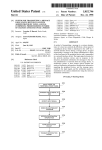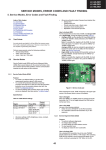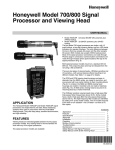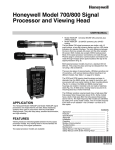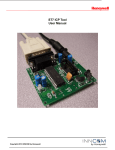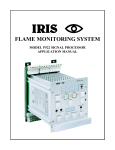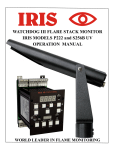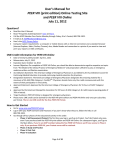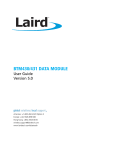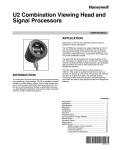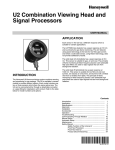Download P532UI User Interface - Lesman Instrument Company
Transcript
MODEL P531, P532 AND P532UI FLAME MONITOR OPERATING MANUAL WORLD LEADER IN FLAME MONITORING TABLE OF CONTENTS DESIGN FEATURES OVERVIEW ................. 1 Parity................................................................. 6 Viewing Head Selection.....................................1 20ma output ...................................................... 6 USER INTERFACE OVERVIEW .................... 1 Default (global default) ...................................... 6 Default Settings .................................................2 FLAME RELAY CONTROL ............................ 6 Numerical configuration.....................................2 Flame On, Flame OFF ...................................... 6 Alternate – Primary............................................2 Temperature display ......................................... 6 DEFAULT DISPLAY FOR P532, P532 UI ..... 2 AUTOMATIC SETUP...................................... 6 Flame count.......................................................2 Fit ...................................................................... 6 Lockout..............................................................3 Fit procedure ..................................................... 7 Alternate Indicator .............................................3 Sequence .......................................................... 7 Hot Viewing Head Indication .............................3 Sequence Procedure ........................................ 7 Primary / Alternate selection..............................3 Filter .................................................................. 8 Using the Prim/Alt switch...................................3 P531 AND P532UI .......................................... 8 To reset Modbus Prim/Alt register .....................3 Display for P531................................................ 8 Non-Advanced viewing heads ...........................3 Flame On .......................................................... 8 Replacing viewing heads...................................4 Flame Signal: .................................................... 8 MENU STRUCTURE ...................................... 4 LOCKOUT ........................................................ 8 Viewing Head Set ............................................4 Status................................................................ 9 Viewing head parameters (gains and filters) .....4 P522 MODE .................................................... 9 Channel Set.......................................................4 P522 mode operation........................................ 9 Associate Viewing head with channel ...............4 INFRARED GAIN............................................ 9 FFRT .................................................................5 Gain boundaries................................................ 9 Delay On ...........................................................5 INSTALLATION NOTES............................... 10 Analog out gain .................................................5 Mounting: ........................................................ 10 Alarm Set point..................................................5 Power connection:........................................... 10 Temperature Alarm (Viewing Head) ..................5 Remote 20 mA ............................................... 10 Default (Channel) ..............................................5 Relays ........................................................... 10 Option Menu......................................................5 Flame Relays .................................................. 10 Address .............................................................5 Alarm Relays................................................... 10 Baud ..................................................................5 Viewing head (See Figures 1 and 2) ............... 10 Power Reset......................................................5 Alternative Setting Selection ........................... 10 Panel ................................................................6 P522 Mode ..................................................... 10 TROUBLESHOOTING NOTES ....................10 If the display is blank: ...................................... 10 If only one line is blank: ................................... 10 If the viewing head is not listed. ..................... 11 Channels display LKOUT ................................ 11 The Display flashes “HOT” ............................. 11 CODE display.................................................. 11 MODBUS PROTOCOL .................................12 Legacy Modbus support .................................. 12 Extensions ...................................................... 12 Modbus function support: ............................... 14 CONTACT INFORMATION...........................14 Sales and applications support: ...................... 14 Factory and repairs: ........................................ 14 SPECIFICATIONS ........................................23 Electrical - Model P531 AC, P532 AC ............. 23 Electrical - Model P531 DC, P532 DC............. 23 Outputs............................................................ 23 Inputs .............................................................. 23 Serial Communications ................................... 23 Flame .............................................................. 24 Compatibility.................................................... 24 Fuses .............................................................. 24 Maintenance.................................................... 24 Cleaning .......................................................... 24 Cable............................................................... 24 Environmental ................................................. 24 IRIS MODELS P531, P532 AND P532UI OPERATING MANUAL DESIGN FEATURES OVERVIEW The IRIS Models P531and P532 feature a new design in flame monitoring technology. The dual processor system is capable of monitoring three viewing heads simultaneously. It can also monitor both UV and IR separately from one S55xx viewing head. In addition, three marginal alarm relays can be configured to provide a secondary indication if the flame count falls below set point or if a viewing head temperature reaches 70° C (158° F). The P532 and P532UI makes use of three scrolling dot matrix displays capable of displaying alphanumeric characters in three different colors as follows: Red indication for IR Green indications for UV Orange indication for mixture of UV and IR The P531 Signal Processor uses seven discrete LED’s for display. These include: Tricolor flame strength flashing indicators for each channel. 3. Auto Filter: Used for definitive infrared calibration. The sequence procedure (above) is performed on each of the 8 filter settings. The bestdifferentiated filter is chosen and configured for gain, flame on and flame off settings. The P532 provides the use of a lockable front panel for restricting unauthorized access. The P531 uses the removable P532UI to achieve this feature. Both Signal Processors have viewing head error detection with viewing head lockout capabilities. (this requires user intervention) A P522 operation mode can be achieved by installing a jumper between the two P522 pins. Changing viewing head types (while the system is operational) will cause the processor to go into lockout mode. (This is a safety feature). The P531 and P532 are compatible with RS-422 and Modbus protocol, and are field upgradeable with firmware download capabilities. Viewing Head Selection. Relay and status indicators. In addition to automatic viewing head detection, each channel and viewing head can be associated with two sets of configuration data as follows: 1. Primary: This is the normal viewing head configuration. 2. Alternate: This is a set of alternate settings that can be activated by applying a voltage across the alternate select pins for each specific channel or writing configuration to Modbus register. Automatic set up functionality is a feature whereby each channel can be configured automatically in one of three ways: IRIS Models S702 / S802 IR and the S706 / S806 UV viewing heads can be connected to Viewing Head #3. Viewing head #3 will default to be assigned to channel “A”. IRIS Models S552 IR and S556 UV together with the S550 that utilizes both UV and IR sensors can be connected to Viewing Head #1 and #2. Viewing Head #1 will default to be assigned to channel ‘B”. Viewing Head #2 will default to be assigned to channel “C”. Note: Alternate channels default to NONE USER INTERFACE OVERVIEW 1. Auto Fit: The flame is monitored and the gain is adjusted to produce an optimal count of between 1100 and 1300. The flame on will then be set at 800 and flame off will be set to 600. 2. Auto Sequence: The gain will first be adjusted as in the Auto Fit routine and then the flame on and flame off settings will be adjusted. (This requires turning off the flame). Page 1 The P532 front panel and the P532UI (User Interface) makes use of nine push buttons for operation. Each of these buttons has at least one specific purpose. All access to the front panel operation is initiated by pressing and holding a button for two seconds (this eliminates the possibility of inadvertent access). In all cases, only the available options will be displayed. IRIS MODELS P531, P532 AND P532UI OPERATING MANUAL There are three menu branches: 1. Channel menu has all configuration items associated with the channel. Alternate – Primary (during configuration) The top line will display ALT or PRIM, followed by : Channel letter (A, B, or C) 2. Viewing head menu has all configuration items associated with the Viewing head. OR Viewing Head number (1, 2, or 3) 3. Options menu has global and system configuration items and information. Note: The RESET button will return you to the default display from any place in the menu structure. If left for a period of time without intervention, the display will revert back to the default display. (Except during auto calibration modes) A channel (Primary and or Alternate) can be assigned to a viewing head (or viewing head sensor in the case of advanced S550x viewing heads). Default Settings Default choices are available in two menus. 1. Channel (Primary and or Alternate) defaults all parameters under the channel menu except for the viewing head association. The viewing head (or the viewing head sensor) assigned to the defaulted channel will also be defaulted. 2. Options defaults all channels and viewing heads as well as resetting the system wide parameters and viewing head to channel association. Note: The response to YES is always the STORE button. Numerical configuration. Green is the current set point stored in memory. Orange indicates that the setting has been changed but not saved yet. The color of this line (top) Red indicates that this configuration is active at present Green indicates a non active configuration. The CHANNEL button will toggle between these two configurations. Alternate configurations can be activated by applying a voltage across the select terminals. DEFAULT DISPLAY FOR P532, P532 UI The default display will appear most of the time. Each line on the display will always be associated with the same channel. The default display will show the flame count for all 3 channels. IR saturation is indicated by flame counts of 9999 Flame count Normal Flame counts are in the range of 0 to 3500 for the S55x viewing heads and 0 to 3000 for S70x / S80x viewing heads (viewing head #3) A red display will indicate that channel is associated with the IR only portion of a viewing head’s output. (Saturation is indicated for advanced viewing heads only) A green display will indicate that channel is associated with the UV only portion of a viewing head’s output. The speed of changing numerical values is accelerated as the key is held down. An orange display will indicate that channel is associated with a mixture of both IR and UV from a S550 viewing head. The UP and DOWN buttons are used to change numerical values or to jump between configuration parameters. A Blank Line indicates that no viewing head is associated with the channel. The SELECT button is used to jump to the next item in all 3 of the menu structures, or to select intermediate parameters that will not be stored. This could also indicate that the gain of an associated sensor is zero. Page 2 IRIS MODELS P531, P532 AND P532UI OPERATING MANUAL A Bar Graph will be displayed in the last digit of the default display. The configuration is written to Modbus register The Primary configuration will be used for operation if: The graph is proportional to the analog output (20ma) and is affected by the flame count and the analog gain for the channel. Lockout LKOUT will be displayed on the panel if a viewing head error has occurred. (Flame relays will trip and the channels will remain locked out until any button is pressed on the front panel). Lockout will also occur when an unexpected viewing head is detected. This will occur when changing head types or attaching new viewing heads to a system that has been defaulted. LKOUT Cannot be cleared by a power reset (to clear push any button) Verification of all viewing head and channel parameters is required after a lockout has occurred. Alternate Indicator The middle pixel of the rightmost column will be illuminated if the Alternate configuration for that channel is currently in operation. Hot Viewing Head Indication A warning will be displayed for 1 second in each 4 seconds if a viewing head attached to Viewing Head #1 or Viewing Head #2 terminals exceeds a temperature of 70° C (158° F). Seeing that the viewing head may not be associated with any particular channel the number of the offending viewing head will be displayed. No voltage is present and Modbus is configured for Primary (default) To reset Modbus Prim/Alt register Use the serial RS-422 communications port (see Modbus register map) Doing a system default (Options / Default) will set this register to Primary for all channels. Non-Advanced viewing heads (S550 models with no following letter designation) The processor treats non-advanced viewing heads as a single sensor. The UV and IR cannot be separated as with the advanced viewing heads. To configure for UV only the IR gain should be set to zero, conversely the IR only can be seen if the UV gain is set to zero (note the appropriate color change of flame count display). These two configurations can be saved in primary and alternate for a single channel and switched when needed. Individual sensors of advanced viewing heads (and non-advanced viewing heads) can be assigned to channel configurations Primary and Alternate. A sensor CANNOT be assigned to more than one channel and a primary and an alternate configuration all at the same time. Except for this notification, no other action is taken when a viewing head is hot. A sensor can be assigned to both Primary and Alternate configurations of the same channel (but not to another channel) Primary / Alternate selection OR Two sets of configuration data can be stored and used for each of the 3 channels. A sensor can be assigned to more than one channel (all either primary or alternate). Both the alternate and primary configurations can be viewed and adjusted from the panel. All channel parameters settings can be configured for both Primary and Alternate usage. Using the Prim/Alt switch. The color of the words PRIM or ALT in the display indicates if it is the current configuration in use. The Alternate configuration is used for operation if: RED selected. A voltage is applied across the associated alternate select pins, OR Page 3 Green not selected. IRIS MODELS P531, P532 AND P532UI OPERATING MANUAL A letter or a number will be displayed after the selection indicating the Channel of Viewing head that is being configured or viewed. Letters (A, B, C) indicate Channels Numbers (1, 2, 3) indicate viewing head numbers Note: Invalid configurations will not be allowed and an “IN USE” warning will be displayed if the sensor is already in use by conflicting configuration. The offending configuration that is using the sensor must be configured to either use a different sensor or use no sensor at all (NONE). Replacing viewing heads If a viewing head is replaced with a different type (model), all channels using the head will lockout. Only one button press is required to clear all lockouts. Toggle primary and alternate viewing head parameters using the CHANNEL button. The appropriate configuration can be selected with the SELECT button. Display of (PRIM/ALT) in Red indicates that the displayed parameter is being used by the channel selection (for the control of the channel relays). Viewing head parameters (gains and filters) The valid parameters for the viewing head can be scrolled through using the SELECT button. The current stored setting will be displayed in green. To adjust the gains and filters the UP and Down buttons will be used. The STORE button must be pressed to store the appropriate setting. If more than one channel or Alternate/Primary configuration was using the head then the channel assignments will be set to none. Channel Set Advanced viewing heads will be assigned to Primary for one of the previously used channels only. Scroll between channels “A”, “B”, and “C”, using the UP, DOWN, or CHANNEL SET buttons. All viewing head gains and filters will be set to default values. Select the Channel to view or configure with the SELECT button. The viewing head associated with the channel will now be displayed. Both Primary and Alternate settings will be defaulted. Note: Changing viewing heads (to that of the same Model) while the unit is operating may cause a lockout. (Cleared with a press of a button). MENU STRUCTURE Three menus are accessible from the front panel. Pressing and holding the appropriate button for 2 seconds will open the menu. Viewing Head Set Viewing head selection : (See Flow Chart 1) Channel selection: (See Flow Chart 2) The top line of the display will indicate either PRIM or ALT along with the channel letter. Toggle between these using the CHANNEL button. Scroll through the channel menu items using the SELECT button. Associate Viewing head with channel Associating a viewing head with the channel can be done by scrolling through the viewing heads using the UP and DOWN buttons. Then select the viewing head with the STORE button. If an advanced viewing head is selected with the STORE button from the channel Viewing head selection menu, then another menu choice will appear IR UV. All attached viewing heads can be scrolled through using the UP and DOWN or the VIEWING HEAD SET buttons. The viewing head to be accessed can be selected with the SELECT button. The top line of the display will indicate either PRIM or ALT along with the viewing head number. Using the UP or DOWN buttons scroll among 1. Both IR and UV will be mixed for this channel 2. IR? - Only IR will be used for this channel Page 4 IRIS MODELS P531, P532 AND P532UI OPERATING MANUAL 3. UV - Only UV will be used for this channel Temperature Alarm (Viewing Head) The appropriate choice must be stored with the STORE button. The Alarm relays can be configured to energize if a viewing head with a temperature sensor gets hot (70° C (158° F) or above). If association is invalid (the sensor is associated with another channel and Alt) “IN USE” will be displayed. The channel that is using the sensor must be disassociated, either by selecting another sensor for that channel or setting it’s sensor association to NONE. Set both Primary and Alternate Alarm set points to ZERO Channel A alarm is for Viewing head #1 Channel B alarm is for Viewing head #2 FFRT Viewing head #3 has no temperature feature. Using the UP and DOWN buttons then STORE the Flame Failure Response time. To set both Alarm set points for one channel first set one of the set points to zero then press CHANNEL button to access the other. (note the change in the top line of the display). FFRT Nominal Opening Maximum FFRT 1 1 sec 2 sec Default (Channel) 2 2 sec 3 sec To reset the channel to default values: 3 3 sec 4 sec Delay On Scroll to YES using the UP or DOWN buttons and then press the STORE button. The STORE button must be pressed again to answer the “are you sure?” question. Using UP and DOWN button and STORE the Delay relay on time. Option Menu Analog out gain System wide configuration parameters Selecting this parameter (with either the UP or DOWN button) will cause the display to change. (See Flowchart 3) The Gain (0 – 100) will be displayed on the line associated with the channel being adjusted in the color associated with the flame count. There will be a bar graph that is proportional to the analog (20ma) output for that channel. (Selected channel only.) Adjusting the gain using the UP and DOWN buttons will (in real time) produce outputs on the analog output pins and on the bar graph proportional to the current flame count. Real time bar graph display of the analog gain setting will be calculated from the fame count of the channel selection Alarm Set point Using the UP and DOWN buttons then STORE the Alarm set point. The alarm relay can be disabled by setting this parameter to zero. Page 5 Address Using the UP and DOWN buttons, enter the value for the RS-422 node address. (Default is zero) The P532 will not respond to the Zero “Broadcast” address. Baud Using the UP and DOWN buttons, toggle between baud rates for the RS-422 press then STORE to accept. (Default is 9600) Power Reset To reset the power: Scroll to YES using the UP or DOWN buttons and then press the STORE button. The STORE button must be pressed again to answer the “are you sure?” question. This cycles power to all the viewing heads and restarts both processors. IRIS MODELS P531, P532 AND P532UI OPERATING MANUAL Panel The front panel can be disabled for configuration changes by entering a LOCK CODE. The lock code is available from Iris Systems. If panel is locked: All parameters are viewable but none can be changed. Parity Using the UP and DOWN buttons, toggle between parities for the RS-422 press then STORE to accept. (Default is none) 20ma output Using the UP and DOWN buttons, toggle between the 0 to 20 ma output or the 4 to 20 ma output then STORE to accept. (Default is 4 to 20). Default (global default) To reset the system to default values: Scroll to YES using the UP or DOWN buttons and then press the STORE button. The STORE button must be pressed again to answer the “are you sure?” question. All channels will be associated with the default viewing heads, all channel set points will be defaulted, and all viewing head parameters will be set to default values (both Primary and Alternate). Channels will be set to 4 – 20 ma output mode. FLAME RELAY CONTROL The main flame relays are controlled by the Flame On and Flame Off settings. The relays are energized once the flame count has exceeded the Flame On setting for Delay ON consecutive seconds. Conversely the relays are de-energized once the flame count has been less than Flame Off setting for FFRT consecutive seconds. (See flowchart 4) Flame On, Flame OFF Hold either of these buttons for 2 seconds to enter the relay menu. Push the SELECT button at any time to change to the next available channel. Pushing the CHANNEL button will toggle between ALT and PRIM settings (red display of Prim/Alt will indicate parameter is currently active) Pushing either the FLAME ON or FLAME OFF will display the current set value in green. Use the UP and DOWN buttons to change the settings of these parameters and STORE to save the values. Temperature display See Configuration control charts 1 and 2 The temperature of a supported viewing head will be displayed when the TEMP button is held for 2 seconds. This display will also show the model of the viewing head. Certain versions of the S550 were produced without a temperature sensor. These will display zero for temperature. AUTOMATIC SETUP The flame monitor can be configured automatically in two different ways. Seeing that this configuration is for a specific channel it therefore falls under the channel menu. Only a currently selected channel can be set up automatically, as indicated by a red Prim/Alt display Fit The auto fit menu is entered by selecting AUTOMATIC from the channel menu. The auto fit configuration only affects the gain of the specific sensor selected and Flame On and Flame Off set points). A channel utilizing 2 simultaneous sensors (S550) cannot be calibrated with this procedure. It is necessary to have a flame present to use auto set. The gain will be set so that the flame count for the specific sensor is between 1100 and 1300. The Flame On will be set to 800 and Flame Off to 600. If this is unobtainable, a message will be displayed indicating the flame is too high or too low. (High flame requires the installation of an orifice). Note: If a channel is using two sensors a choice will be given to turn one or the other of these sensors off. The corresponding gain will be set to Zero for S550 viewing heads or the sensor will be selected for the specific channel for advanced viewing heads Page 6 IRIS MODELS P531, P532 AND P532UI OPERATING MANUAL Fit procedure 1. 2. 3. Using the channel menu procedure (above) select the AUTOMATIC menu branch by toggling to yes using the UP or DOWN buttons and press STORE. If prompted to turn off a sensor, use the UP or DOWN button to display the sensor that is to be turned off then press SELECT to turn it off. If prompted to UNCAL a channel (see note above), press the STORE button to answer the YES? Query to acknowledge the side effect this will have on the other channel. 4. Using the UP or DOWN buttons, scroll to FIT and press SELECT to select the automatic fit procedure. 5. If TURN FLAME ON is displayed (the flame relay is not energized) turn the flame on. Calibration will not continue without the flame relay being energized. Note: Calibration cannot be done with the flame relay off. Prior to entering the Automatic menu sufficient flame/gain combination must be available to ensure the flame relay will be energized. A rejected gain calibration can occur if fluctuations of signals are detected during calibration or if the signal is such that the gain cannot be determined automatically. Note: In certain cases acceptable results may be obtained by manually setting the gain to the processors best guess and then re running the procedure. Sequence Auto Sequence configures the gain and relay set points for a specific channel. When entering the auto sequence configuration, the auto fit procedure (above) will be automatically performed first. Once the proper gain setting has been established, the system will take samples of the flame to eliminate flicker error. Flame on will be sampled for 60 seconds and flame off (dark) will be sampled for 60 seconds. Flame sample times can be shortened by pressing a button. However, a minimum of 10 seconds is required. If the RESET button is held for 1 second the procedure will abort. Sequence Procedure 1. Using the channel menu procedure above, select the AUTOMATIC menu branch by toggling to yes using the UP or DOWN buttons and press STORE. 6. Fit calibration will take less than 17 seconds. A countdown timer will display the maximum remaining seconds. 7. Completion of Fit calibration will display: 2. AUTO FIT OK! Completion of successful gain calibration. New gain parameters are stored and the display will revert to default display. Using the procedure outlined in Fit Procedure above, follow all steps except SELECT SEQUENCE from step 4 above. 3. Once the Fit portion of the Sequence calibration has been successfully completed: 4. START BURN YES? Question will be asked, press the STORE button to start the 60-second count down for the flame on (bright) portion of the calibration. 5. Flame samples times can be shortened by pressing a button for 1 second. However, a minimum of 10 seconds is required. LOW FLAME SIGNAL Insufficient flame signal to allow for optimal flame count output. Install orifice with larger hole. Original calibration will be restored. HIGH FLAME SIGNAL flame signal too strong to allow for optimal flame count output. Install orifice with smaller hole. Original calibration will be restored. GAIN REJECTED Number. If the unit cannot attain appropriate gain calibration within the time allotted “REJECTED” will be displayed along with the type of gain being adjusted and the processors best guess for gain calibration. Page 7 IRIS MODELS P531, P532 AND P532UI OPERATING MANUAL 6. A countdown clock will be displayed on the bottom line indicating the remaining time in seconds. 7. After the completion of the bright time period a TURN FLAME OFF command will be displayed followed shortly with the FLAME OFF? Question. 8. The Flame must now be turned off. 9. Once the flame is off, pressing the STORE button to start the dark period counter. (Dark sample times can be shortened by pressing a button for one second. However, a minimum of 10 seconds are required.) 10. After completion of the dark sequence portion, an evaluation will take place and a prompt will appear. If the setting parameters are outside of reasonable bounds, the sequence will be rejected (SEQUENCE REJECTED). The problem should be corrected before another sequence is attempted. A successful sequence is indicated by all green display. A marginal sequence is indicated by an orange display. Top line will display Flame On set point. Second line will display Flame Off set point Third line will display the channel that was adjusted. In the case of a marginal sequence, a YES prompt will have to be answered with the STORE 11. If the Sequence is rejected, either automatically or by the user, the original settings will be restored. Filter The Gain will be readjusted at each filter setting and the flame will be sampled for 20 seconds at each level. This calibration will take about 8 minutes Flame on will be sampled for 20 seconds and flame off (dark) will be sampled for 20 seconds. Flame sample times cannot be shortened in the auto Filter procedure. The filter can be aborted by holding the reset button for one second. P531 AND P532UI Setup and operation of the P531 is the same as for the P532 when using the P532UI The P532 UI can be connected to and disconnected from the P531 during operation for monitoring and configuration. Other methods of monitoring and configuration include Modbus devices (either through the RS-422 port or the RS-232 port). Display for P531 The 7 LED’s on the P531 will provide information about status and flame signals for all channels. Flame On The display has software indication that the Flame relay is energized Note: as with the P532 this is not a hardware LED Flame Signal: Indication of the flame strength flashes From one flash every few seconds to rapid flash The color indicates signal configuration: (channel configured for: ) Red indicates IR only Green indicates UV only Auto Filter configures the gain and relay set points for a specific infrared channel When entering the auto Filter configuration, the auto fit procedure (above) will be automatically performed first. IF proper gain setting can be established, the system automatically runs a shortened version of the Sequence (above) configuration on all 8 filter levels. Orange indicates the channel is configured to detect both UV and IR LOCKOUT Red Green Red Green ….. Flashes once a second. The Flame On indicator will be out. Push the reset button to clear lockouts. (This is the only way to clear a LOCKOUT) Page 8 IRIS MODELS P531, P532 AND P532UI OPERATING MANUAL Status INFRARED GAIN A Green heartbeat (one quick green flash each second) indicates system normal (self check) Analysis of the Electrical and Digital (Software) gains for the S55xx Viewing Heads. A Red / Green heartbeat (alternating color one quick flash each second) indicates one or more viewing heads are Hot (70 deg C or more). Other system functions are normal. The Sx55x viewing heads that are IR equipped have a two stage gain system. A Red Inverted heartbeat (Red light with one quick flash dark each second): The display processor is not receiving data from signal processor. (Interprocessor communications error.) A solid color light or no light or any other flash pattern indicates a system failure. No LED’s illuminated could also indicate a power loss. P522 MODE The P532 can be made to behave like the P522 Connect a jumper between ground and the P522 pin. The unit will revert to P522 the next time it is powered up. There is a 7 step electrical “analog” gain that is used external to the processor to amplify the signal before it enters the processor. Indicated by the left digit. Once the signal is at the processor, a “digital” software gain can then be applied. Indicated by the last two digits. These gain adjustments may not be transparent to the user as a slight amount of non-linearity may occur when changing from one electrical gain setting to another. During setting a hysteresis is built in to keep small changes in the digital range. If an analog gain boundary is crossed, a finer adjustment can be achieved by going back in the other direction. There is no support for viewing head #3 in this mode. NOTE: If the jumper is installed or removed and the power is reset then the entire system will revert back to default settings. P522 mode operation Note: illegal values for gain between x00 and x37 (except for low range). Gain boundaries The following table is a list of boundaries, for changing the electrical gain. Channel Viewing Head assignments: Channel A Only will be operational (both Prim or Alt) IR gain settings transitions for the S55xx viewing heads. P 522 will be displayed on the second line Only channel A Flame relays will operate If power is applied across Alternate 1 pins, the channel will revert to the Channel A Alternate configuration parameters. The bottom line will display the active selection. From To Electrical gain 0 99 1 138 199 2 238 299 4 338 399 8 The channel A marginal alarm will function independently. 438 499 16 538 599 32 The alarm can be disabled by setting the trip point to zero. 638 699 64 Separation of UV and IR is supported for advanced viewing heads. Page 9 IRIS MODELS P531, P532 AND P532UI OPERATING MANUAL INSTALLATION NOTES Viewing head (See Figures 1 and 2) Mounting: Viewing heads are connected to the appropriate terminals using the compatibility list. The P531 or P532 Signal processor should be mounted (using the 4 holes in the corners of the base) to a vertical surface in a location with free air circulation on the top, bottom and sides. Source Impedance Resistors 470 Ohm ¼ Watt must be installed between SC and SGND for all cable runs to S55x viewing heads between 300 and 700 ft. Power connection: Alternative Setting Selection DC units should be connected to a stable 24-volt DC supply. For each of the 3 viewing heads: AC units should be connected to an AC mains supply Connect +Sel and ground through a switch from a DC supply for selecting alternate viewing head settings. Battery backup can be connected to the +24 BATT terminal. The +24v OUT terminal can be used to supply power for this purpose (on AC units). To prevent discharging the battery, its voltage must be less than the main supply (for DC units) or less than 24 volts (for AC units). This can be adjusted using series silicon diodes to provide a voltage drop of 0.7 volts each. P522 Mode To Use the P532 in Reduced Feature mode install a jumper between the P522 mode terminal and ground. Remote 20 mA Then power must then be cycled. Current meters can be connected to the remote meter outputs with the RET as a common return. WARNING: Do NOT connect P522 mode terminal to a power source. Relays (See Figures 4 and 5) Self-check contacts are provided for both normally open and normally closed positions. Connect the Self-check actuator to whichever of these terminals is required. The Self-check relay is internally interlocked with the flame relays so that whenever the Self-check relay opens all of the flame relays will open as well. TROUBLESHOOTING NOTES If the display is blank: Unplug all viewing heads (should display “NO VH# DETECTED”). If display still blank then: Hold the Reset button for 2 seconds: If address is displayed then reset factory defaults: Else return unit to factory for service. Flame Relays If only one line is blank: Each of the flame relays provides 2 sets of normally open and normally closed positions. Connect the Burner supply to the required flame terminals. Alarm Relays Alarm contact is a normally open contact that will provide a connection to it’s RET when the flame count falls below the set point. Or (if configured) the viewing head temperature exceeds 70° C (158° F). Connect the Alarm actuator to these terminals. Check that the channel is associated with an operational viewing head. Push channel until the channel letter is displayed then push select. Scroll through viewing heads and store the one required. If the Channel is associated with a viewing head, check that the viewing head’s gain is not set at zero. Page 10 IRIS MODELS P531, P532 AND P532UI OPERATING MANUAL If the viewing head is not listed. If the viewing head is not listed as a choice in either the Viewing head or the channel branch: Check that the viewing head is compatible with the P531/P532. Check that the viewing head cable is in good condition. Verify that 24 volts DC is present at the cable head. Note: power to VH #3 is pulsed when no viewing head has answered. Check that the viewing head is operational. A meter or Oscilloscope on the SC with reference to ground will show: At least 20% duty cycle at 15 volts Peak for S55x viewing heads. At least 10% duty cycle at 24 volts Peak for S70x/S80x viewing heads. With S70x and S80x viewing heads the Green LED will flash once per second. S55xx viewing heads will show a number on the display. Viewing heads without numeric displays will flash if flame signal is present. Substitute a known good viewing head using a known good cable. Channels display LKOUT Channels display LKOUT that will not stay cleared (after pressing any key). Viewing head problem or cable problem. See above steps. (Reset OPTION defaults). The Display flashes “HOT” Indicates that the viewing head listed is nearing or exceeded maximum operational temperature. The system will try to continue operating as long as it can and the flashing display is only a warning. CODE display. This is an indication of a processor failure. It can be caused by a power failure during a memory store operation or other more serious fault. Page 11 If the unit is not restored by cycling the power and setting factory defaults: Record the numbers on the display. Remove the unit from service and return it to the factory for failure analysis and repair. IRIS MODELS P531, P532 AND P532UI OPERATING MANUAL MODBUS PROTOCOL Legacy Modbus support * 40001 Flame Count (active channel in 522 mode) other wise ZERO * 40002 Processor Status R/O 0x or Discrete * 000001 viewing head channel selected 0=Chan A (same pin 4 VH1 gain select) * 000002 flame on relay status (not used for P532) (reads zero) * 000003 Processor Lockout status 0 = lockout (any channel locked out) * 000004 Panel access disabled 0 = disabled * 000005 4 - 20 ma output 0 = 0 to 20 ma output Primary * 40003 Flame On Channel A (0 -> 2999) * 40004 Flame On Channel B (0 -> 2999) * 40005 Flame Off Channel A (0 -> 2999) * 40006 Flame Off Channel B (0 -> 2999) * 40007 Gain Channel A 20ma Gain Primary (0 -> 99)(0 – 100 for P532) * 40008 Gain Channel B 20ma Gain Primary(0 -> 99) (0 – 100 for P532) * 40009 IR Analog Gain VH 1 (portion of total IR gain) (R/O P532) * 40010 IR Digital Gain VH 1 (portion of total IR gain) (R/O P532) * 40011 IR Filter VH 1 (unsigned char) (1 -> 8) * 40012 UV Gain VH 1(unsigned char) (0 -> 99) * 40013 IR Analog Gain VH 2 (portion of total IR gain) (R/O P532) * 40014 IR Digital Gain VH 2 (portion of total IR gain) (R/O P532) * 40015 IR Filter VH 2 ( 1 -> 8) * 40016 UV Gain VH 2 ( 0 -> 99 ) * 40017 Viewing head type Viewing head #1 R/O * 40018 Viewing head type Viewing head #2 R/O * 40019 Temperature Channel A R/O * 40020 Temperature Channel B R/O * 40021 Time Delay (upper nibble Ch B) Lower nibble channel A (Read change Write) * 40022 FFRT (upper nibble Ch B) Lower nibble channel A (Read change Write) * 40023 Software Versions R/O * 40024 Model number P522 version 5.2 and earlier will read 0 P522 version 5.3 and later will read 520 Alternate viewing head #1 * 40038 IR Gain VH 1 * 40039 IR Filter VH 1 * 40040 UV Gain VH 1 Alternate viewing head #2 * 40041 IR Gain VH 2 * 40042 IR Filter VH 2 * 40043 UV Gain VH 2 Alternate viewing head #3 * 40044 IR Gain VH 3 * 40045 UV Gain VH 3 Alarm set points Primary * 40046 Alarm set point Channel A (0 -> 2999) * 40047 Alarm set point Channel B (0 -> 2999) * 40048 Alarm set point Channel C (0 -> 2999) Advanced viewing head flame counts for S550A and later *40049 Viewing head #1 IR component *40050 Viewing head #1 UV component *40051 Viewing head #2 IR component *40052 Viewing head #2 UV component *40053 Channel "A" R/O * 000001 bit 0 flame relay status * 000002 bit 1 alarm relay status * 000003 bit 2 channel Autoset (Primary or Alternate) * 000004 bit 3 channel lockout (Primary or Alternate) * 000005 bit 4 Primary active = 1 Alternate active = 0 * 000006 * 000007 * 000008 *40054 Channel "B" R/O * 000001 bit 0 flame relay status * 000002 bit 1 alarm relay status * 000003 bit 2 channel Autoset (Primary or Alternate) * 000004 bit 3 channel lockout (Primary or Alternate) * 000005 bit 4 Primary active = 1 Alternate active = 0 * 000006 * 000007 * 000008 Extensions (for P531/P532 (RS-422) to the Modbus protocol) *40055 Channel "C" R/O * 40024 Model R/O P532 will read 532 * 40025 Flame Count channel A (R/O) * 40026 Flame Count Channel B (R/O) * 40027 Flame Count Channel C (R/O) * 40028 Flame On Channel C Primary * 40029 Flame Off Channel C Primary * 40030 Gain Channel C 20ma Gain Primary (0 -> 100) * 40031 IR gain VH 3 (1 to 9) Primary * 40032 UV Gain VH 3 (Total UV gain for P532) (unsigned char) (1 -> 9) Primary * 40033 Viewing head #3 type R/O * 40034 Time Delay Channel C Primary * 40035 FFRT Lower nibble channel C Primary * 40036 IR Gain Viewing Head #1 (primary) (equivalent to 40009 and 40010) * 40037 IR Gain Viewing Head #2 (primary) (equivalent to 40013 and 40014) * 000001 bit 0 flame relay status * 000002 bit 1 alarm relay status * 000003 bit 2 channel Autoset (Primary or Alternate) * 000004 bit 3 channel lockout (Primary or Alternate) * 000005 bit 4 Primary active = 1 Alternate active = 0 * 000006 bit 5 * 000007 bit 6 * 000008 bit 7 Page 12 IRIS MODELS P531, P532 AND P532UI OPERATING MANUAL *40069 *40056 Channel "A” Primary Read/Write Channel "A” Alternate Read/Write * 000001 bit 0 * 000002 bit 1 * 000003 bit 2 * 000004 bit 3 * 000005 bit 4 (bit 4 and 5 are viewing head attached to channel) * 000006 bit 5 0 ,0 = no viewing head 0,1 = vh #1 ….etc. * 000007 bit 6 IR // for Advanced viewing heads * 000008 bit 7 UV // for Advanced viewing heads * 000001 bit 0 * 000002 bit 1 * 000003 bit 2 * 000004 bit 3 * 000005 bit 4 (bit 4 and 5 are viewing head attached to channel) * 000006 bit 5 0 ,0 = no viewing head 0,1 = vh #1 ….etc. * 000007 bit 6 IR // for Advanced heads * 000008 bit 7 UV // for Advanced heads *40070 *40057 Channel "B” Primary Read/Write Channel "B” Alternate Read/Write * 000001 bit 0 * 000002 bit 1 * 000003 bit 2 * 000004 bit 3 * 000005 bit 4 (bit 4 and 5 are viewing head attached to channel) * 000006 bit 5 0 ,0 = no viewing head 0,1 = vh #1 ….etc. * 000007 bit 6 IR // for Advanced viewing heads * 000008 bit 7 UV // for Advanced viewing heads * 000001 bit 0 * 000002 bit 1 * 000003 bit 2 * 000004 bit 3 * 000005 bit 4 (bit 4 and 5 are viewing head attached to channel) * 000006 bit 5 0 ,0 = no viewing head 0,1 = vh #1 ….etc. * 000007 bit 6 IR // for Advanced heads * 000008 bit 7 UV // for Advanced heads *40071 *40058 Channel "C" Primary Read/Write Channel "C" Alternate Read/Write * 000001 bit 0 * 000002 bit 1 * 000003 bit 2 * 000004 bit 3 * 000005 bit 4 (bit 4 and 5 are viewing head attached to channel) * 000006 bit 5 0 ,0 = no viewing head 0,1 = vh #1 ….etc. * 000007 bit 6 IR // for Advanced viewing heads * 000008 bit 7 UV // for Advanced viewing heads * 000001 bit 0 * 000002 bit 1 * 000003 bit 2 * 000004 bit 3 * 000005 bit 4 (bit 4 and 5 are viewing head attached to channel) * 000006 bit 5 0 ,0 = no viewing head 0,1 = vh #1 ….etc. * 000007 bit 6 IR // for Advanced viewing heads * 000008 bit 7 UV // for Advanced viewing heads *40059 Pin status R/O * 000001 * 000002 * 000003 * 000004 bit 3 522 mode pin PORTC.3 * 000005 bit 4 Channel A Primary = 1 Alt = 0 PORTC.4 (same as 400002 00001) * 000006 bit 5 Channel B Primary = 1 Alt = 0 PORTC.5 * 000007 bit 6 Channel B Primary = 1 Alt = 0 PORTC.6 * 000008 *40060 SERIAL Number R/O *40061 ID number READ and WRITE (Signed Integer) *40062 Operational time each unit = 2 hours of continuous power on time (R/O) *40063 Flame On Channel A alternate (0 -> 2999) *40064 Flame On Channel B alternate (0 -> 2999) *40065 Flame On Channel C alternate (0 -> 2999) *40066 Flame Off Channel A alternate (0 -> 2999) *40067 Flame Off Channel B alternate (0 -> 2999) *40068 Flame Off Channel C alternate (0 -> 2999) Page 13 *40072 Gain Channel A 20ma Gain Alternate (0 – 100 ) *40073 Gain Channel B 20ma Gain Alternate (0 – 100 ) *40074 Gain Channel C 20ma Gain Alternate (0 – 100 ) Alarm set points Alternate *40075 Alarm set point Channel A (0 -> 2999) *40076 Alarm set point Channel B (0 -> 2999) *40077 Alarm set point Channel C (0 -> 2999) Alarm set points Alternate *40078 Time Delay (upper nibble Ch B) Lower nibble channel A (Read change Write) *40079 FFRT (upper nibble Ch B) Lower nibble channel A(Read change Write) *40080 Reserved (do not write to this location) reads zero. *40081 Time Delay Channel C Alternate *40082 FFRT Channel C Alternate *40083 Alternate / Primary Switch register Read/(Write RS-422 only) * 000001 * 000002 * 000003 * 000004 * 000005 bit 4 Channel A Primary = 1 Alt = 0 * 000006 bit 5 Channel B Primary = 1 Alt = 0 * 000007 bit 6 Channel B Primary = 1 Alt = 0 * 000008 IRIS MODELS P531, P532 AND P532UI OPERATING MANUAL To reset factory defaults for P531 front port write 30064 (RS232) *40084 Error code RS422 port only (P531 front port is undefined) CONTACT INFORMATION For further information contact: Sales and applications support: P531 front panel access only (RS232) *40085 Baud for the RS422 port *40086 Parity for the RS 422 port *40087 Modbus Address for the RS 422 port IRIS SYSTEMS INC. 7583 Vantage Place Delta, BC, Canada V4G 1A6 Modbus function support: * 03 Holding Register Read * 06 Preset Single Holding Register * 16 Preset Multiple (Maximum 5 consecutive locations per message) Note: If writing multiple presets a failure message may occur if one of the presets does not fall within parameters. Presets before the invalid data will be written correctly to the register. All parameters after invalid parameter are ignored and an “Illegal data value” message is returned. Ph. 800-667-IRIS, FAX 604-581-9790 email: [email protected] Web: www.iris-systems.com Factory and repairs: IRIS SYSTEMS INC. (JB Systems, Inc.) 4944 113th Avenue N Clearwater, FL 33760 Ph. 727-545-3900, FAX 727-547-9589 Page 14 IRIS MODELS P531, P532 AND P532UI OPERATING MANUAL Channel VH# Sensor Flame ON Flame OFF FFRT Time Delay Analog Gain Alarm A Prim. A Alt. B Prim. B Alt. C Prim. C Alt. TABLE 1: Temperature Configuration Control Chart 1 IR Gain IR Filter UV Gain VH#1 Prim. VH#1 Alt. VH#2 Prim. VH#2 Alt. VH#3 Prim. N/A VH#3 Alt N/A TABLE 2: Temperature Configuration Control Chart 2 Page 15 Channel Association IRIS MODELS P531, P532 AND P532UI OPERATING MANUAL FIGURE 1: Wiring and connections S55xx Viewing Head FIGURE 2: Model 700 and 800 viewing head cable connections Page 16 IRIS MODELS P531, P532 AND P532UI OPERATING MANUAL MODULAR CONN. SCHEM LABEL COLOR TYPE A COLOR TYPE B INTERFACE LABEL DESCRIPTION POWER SUPPLY 1 NC WHI BLU NC NC - 2 TX- BLK YEL RD (A) FROM PROCESSOR - 3 TX+ RED GRN RD (B) FROM PROCESSOR - 4 RX- GRN RED TD (A) TO PROCESSOR - 5 RX+ YEL BLK TD (B) TO PROCESSOR - 6 GND BLU WHI GND GROUND GND +12VDC POWER +12VDC CAUTION: The order of the colors in the cable can be TYPE A or TYPE B. Check colors at the connector. FIGURE 3: Wiring of RS-422 to RS-232 Converter to processor Page 17 IRIS MODELS P531, P532 AND P532UI OPERATING MANUAL FIGURE 4: P532 DC Wiring Diagram Page 18 IRIS MODELS P531, P532 AND P532UI OPERATING MANUAL FIGURE 5: P532 AC Wiring Diagram Page 19 4.56" TYP CHANNEL SET VIEW HEAD SET FLAME OFF STORE P532 FRONT VIEW FLAME MONITOR #2 V.H. TEMP RESET OPTIONS SELECT FLAME ON #1 V.H. TEMP PRESS BUTTONS 2 SECONDS TO ACTUATE MODEL 532 4.19" TYP P532 TOP VIEW 4.25" TYP FLAME ON USER INTERFACE FLAME SIGNAL RESET P531 FRONT VIEW STATUS CHAN C CHAN B CHAN A P531 FLAME MONITOR P531 TOP VIEW P532UI TOP VIEW P531 TOP VIEW VIEW HEAD SET CHANNEL SET SELECT RESET OPTIONS #2 V.H. TEMP #1 V.H. TEMP P532UI FRONT VIEW FLAME MONITOR STORE FLAME OFF FLAME ON PRESS BUTTONS 2 SECONDS TO ACTUATE MODEL 532UI 1.63" 5.80" TYP IRIS MODELS P531, P532 AND P532UI OPERATING MANUAL FIGURE 6: P531, P532, P532UI Dimensions Page 20 IRIS MODELS P531, P532 AND P532UI OPERATING MANUAL Viewing Head Setup Channel (Prim/Alt) Viewing Head Selected “1, 2 or 3” Select IR Gain UV Gain IR Filter #2 Temp #1 Temp STORE ------ FLOWCHART 1: Viewing Head Set, Channel Set and Option CHAN SET #1 Temp. Select VH Sell FFRT Delay On Analog out Alarm Channel Prim/Alt #2 Temp #1 Temp STORE ------ FLOWCHART 2: Channel Set Page 21 Default Auto IRIS MODELS P531, P532 AND P532UI OPERATING MANUAL Options Select Address Baud #2 Temp #1 Temp Power Reset Panel Parity 0-20 4-20 Default #1 Temp #1 Temp #2 Temp STORE -----STORE ------ #1 Temp #1 Temp STORE ------ STORE -----STORE ------ Reset Heads And Processor Reset System Defaults Enter Code Lock/Unlock Routine FLOWCHART 3: Option Menu - System wide configuration parameters Select (Channel) Flame On Flame Off #2 Temp #1 Temp Channel (Prim/Alt) STORE ------ FLOWCHART 4: Flame On / Flame Off Page 22 IRIS MODELS P531, P532 AND P532UI OPERATING MANUAL SPECIFICATIONS Models P531, P532 and P532 UI Electrical - Model P531 AC, P532 AC Primary Input Power 85 – 264 VAC, 47-63 Hz Battery Backup Voltage 24 VDC (voltage above 24 volt will be the power source) Electrical - Model P531 DC, P532 DC Primary Input Power 24 VDC Battery Backup Voltage 24 VDC (power source is taken from the highest voltage) Power (DC unit tested at 100 ms sampling time) 13.2 Watts max. Average (including 3 viewing heads) 16.2 Watts max. Peak (including 3 heads in normal operation) Outputs Flame Relay 3 channels of 2 Form C Contacts (DPDT) Self-Check Relay 1 channel of 1 Form C Contact (SPDT) Contact Rating 5A at 32 VDC and at 250 VAC Alarm Relays 3 channels of 1 Form A Contact (SPST-N.O.) Contact Rating 2 A at maximum 250 VDC or 230 VAC Analog Flame Signal 0 – 20 mA or 4 – 20 mA 1000 ohm maximum resistance Power To Viewing heads 100 mA (maximum average) 24 VDC (rated) Current limited to 200 mA 24v output 24-volt output 50 mA For Instrumentation use only Provided for use with Isolated Select inputs Isolated Select 7.5 – 30 VDC Input Resistance 3900 ohm Aux Mode Connect to ground only (WARNING: do not apply Power) Sources 1 mA at 5 VDC Viewing head Signal (for 55x and 70x) 26-Volt P-P Maximum, 1 MA Inputs Serial Communications RS-422 / 4 wire (two twisted pair) Page 23 Baud 38400, 19200, 9600 or 4800 Parity None, Even or Odd Protocol Modbus (RTU) IRIS MODELS P531, P532 AND P532UI OPERATING MANUAL RS-232 (P531 front panel port only) Baud Parity Protocol 19200 None Modbus(RTU) fixed address of 64 Maximum flame detector response time 5 second Minimum flame detector self-checking rate 1 second Maximum flame failure “lock-out” time 2 to 4 seconds (adjustable) Maximum flame failure response time 2 to 4 seconds (adjustable) Signal for presence of flame Flame on set point (adjustable) Signal for absence of flame Flame off set point (adjustable) Flame No large Maximum flame signal will cause lost flame indication. Compatibility Viewing head #3 S702, S706, S802 or S806 (and -PH and –HF versions) Viewing head #1 or #2 S550x, S552x, S556x (and –PF versions) Fuses No user serviceable components are inside. Self-resetting fuses are provided internally on the following connections: +24 PWR DC input voltage supply (DC units only) +24 BATT Battery input voltage supply These require cooling off period (of no load) to reset. Cleaning Turn power off before cleaning. Only wipe Panel front with a soft cloth (dry or slightly dampened with water). Cable Connection from the Signal processor to the viewing heads shall use approved cable: Cable can be Instrument Tray cable with CIC C22.2 No. 239 certification IRIS C-330 Or must be run inside of Conduit (with properly sealed ends). Environmental Ambient Temperature -40° C to 60° C (FM) or 0° C to 52° C (CSA) Humidity non-condensing Maximum 80% for temperatures below 31° C Decreasing to 50% maximum at 40° C and above Vibration +1 g at 10 to 150 Hz Rev.0405 Page 24




























